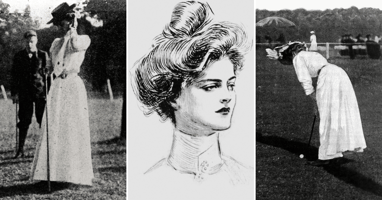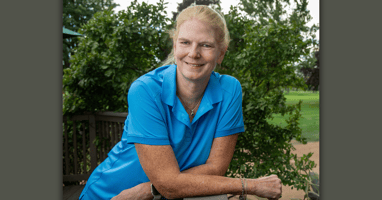First American female Olympic champion was a Chicago golfer who never received a medal Artwork...
June 2024 - History and Literature at 124th Women's Western Am
Return to Onwentsia spurs memories of past champion Edith Cummings
This article appeared in the June 2024 edition of Chicago District Golfer.
To read more Chicago District Golfer stories, head to our article archive.

Onwentsia's par-3 ninth hole will play as the 18th, as it did 100 years ago, for the Women's Western Amateur, July 15-20.
When Onwentsia Club hosted the Women’s Western Amateur (WWA) golf tournament a century ago, one of its own – Edith Cummings – captured the title. For the second time since then, and fifth overall, the Lake Forest club will welcome the tournament from July 15-20, 2024.
The course has changed a great deal since Cummings’ triumph in 1924, as the greens have expanded, prairie grass has been added and new tees have been installed. But Cummings would certainly recognize one feature: the nines will be reversed for the tournament – following the original format that lasted until 1939 – so the par-3 18th hole will feature golfers launching their ball toward the majestic Harrie T. Lindeberg clubhouse while hundreds gather by the two-level green and in Adirondack chairs nearby.
It can be argued that Cummings – whose black-and-white picture graces a wall in the Red Bar inside the clubhouse – was the best-known golfer ever associated with Onwentsia. Part of that was spurred by one of fiction’s greatest works, The Great Gatsby. In real life, Cummings was close friends with Ginevra King – the love of F. Scott Fitzgerald, who based the character of Daisy Buchanan in his famous novel on her. Fitzgerald’s pen transformed Cummings into the golfer Jordan Baker. Wrote Fitzgerald in the novel, “(She) wore all her dresses like sports clothes – there was a jauntiness about her movements as if she had first learned to walk upon golf courses on clean, crisp mornings.”
 Sadie Englemann, 2023 WWA runner up
Sadie Englemann, 2023 WWA runner up
But, as noted in Onwentsia at 125, “There was a major difference between the real person and fictional character. In Fitzgerald’s telling, Jordan Baker was a cheat; Cummings was never accused of dishonesty on or off the golf course.
Eight months before Great Gatsby was published – and only weeks after her victory at Onwentsia – a smiling Cummings became the first woman and the first golfer to appear on the cover of Time magazine. (She was sandwiched between British Prime Minister Ramsay MacDonald, whose visage appeared on the cover the previous week, and followed by Adolph Ochs, publisher of The New York Times.)
Born in 1899 to a wealthy Chicago family, Cummings graduated from the all-girls Westover School in Connecticut. She never attended college. To please her father, she took up golf (her brother Dexter was an intercollegiate champion). Her prowess was apparent by 1922, when she captured the bronze medal at the U.S. Women’s Amateur at The Greenbrier in West Virginia. Opined Cecil Leitch in Golf Illustrated that fall, “Curiously enough, the American women golfers appear to be far behind the American men on and around the green. One notable exception is Miss Edith Cummings, who adds good putting to her fine long game.”
Then came the greatest triumph for the woman known as the “Fairway Flapper”: Cummings won the 1923 U.S. Women’s Amateur Championship at the Westchester Biltmore Country Club in Rye, New York. Glenna Collett, the previous year’s champion, lost in the third round, setting up a final match between Alexa Stirling (a three-time national champion) and Cummings, both of whom were smacking their drives nearly 230 yards. Bedecked in sweaters and wool skirts on a windy day, Stirling took an early lead, but Cummings concluded the match victoriously at the 34th green.
 F. Scott Fitzgerald used Onwentsia member Edith Cummings as a model for the character Jordan Baker, a golfer, in his classic novel The Great Gatsby, published in 1925.
F. Scott Fitzgerald used Onwentsia member Edith Cummings as a model for the character Jordan Baker, a golfer, in his classic novel The Great Gatsby, published in 1925.
Despite her national success, Edith had never captured the Women’s Western Amateur. Yet on her home course among 152 competitors in 1924, she prevailed. As Time magazine wrote, “Edith, who was raised amid Onwentsia's daisies and knows every hole on the prairie, including those made by gophers, had little trouble navigating the rains-soaked course in 84, low medal.”
Edith Cummings eventually married Curtis B. Munson. They had no children. Far from being a demure debutante, Cummings enjoyed big-game hunting, skied up frozen Canadian rivers and volunteered to serve in the Red Cross during World War II. Yet she never forgot the challenge of golf.
“I think it’s the most mental, physical game there is,” she told The Washington Post in 1982, near the end of her life. “You have to have complete control of your nerves and mind. It isn’t any dumbbell's game.”
Today, the Curtis and Edith Munson Foundation contributes to women’s college golf with an annual $5,000 grant, and the Munson Trophy is contested every summer among Onwentsia’s women golfers.
David A. F. Sweet is the author of several books, including “Onwentsia at 125.”





